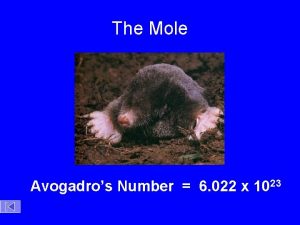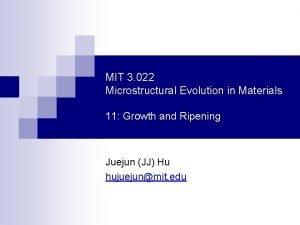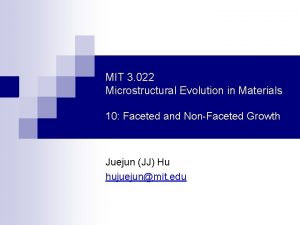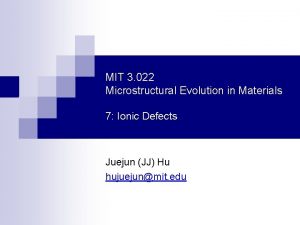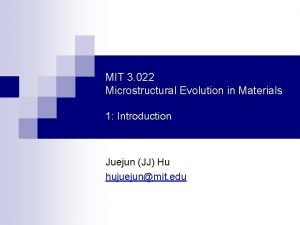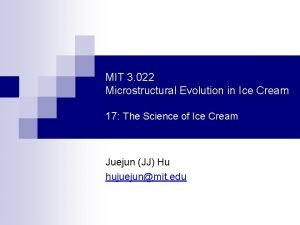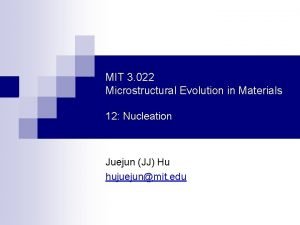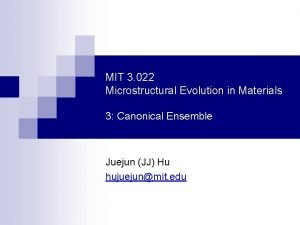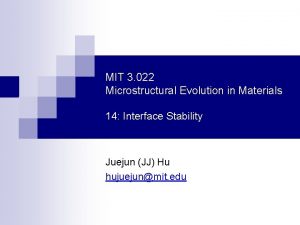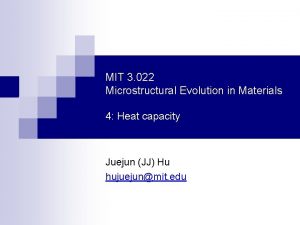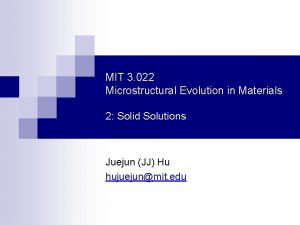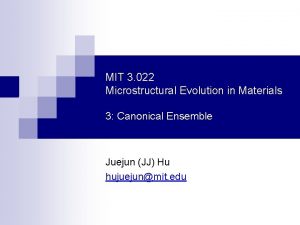MIT 3 022 Microstructural Evolution in Materials 8













- Slides: 13

MIT 3. 022 Microstructural Evolution in Materials 8: Ionic Conductivity Juejun (JJ) Hu hujuejun@mit. edu

Electrically conductive glass?

Chemical potential and electrochemical potential n Chemical potential: Gibbs free energy associated with one single particle in the absence of electric field Ideal solution: n Electrochemical potential And this thing is called “electrochemical potential”… This is called “chemical potential” or “Fermi level” in 3. 024! Electrostatic potential energy

Thermodynamic driving force for diffusion n Average velocity of a diffusing species A n Thermodynamic driving force n For an ideal solution of A Einstein relation

Driving force for ion migration n Flux of ion migration Diffusion term Drift term n Diffusion: net motion of ions driven by concentration (chemical potential) gradient n Drift: directional motion of ions driven by electric field (electrical conduction)

Ionic conductivity n Current density carried by drifting ions: n Total conductivity: n In the lecture notes: Faraday constant

Temperature dependence of ionic conductivity Intrinsic crystal: Doped crystal: Ionic conductivity of various solid electrolytes

What do a 2012 Volkswagen Diesel Sedan and a Ti. O 2 crystal in equilibrium have in common? n They are both defective © AA 1 Car. com Resistive Ti. O 2 exhaust gas oxygen sensor https: //www. ngk. de © NGK Spark Plug Europe http: //www. aa 1 car. com/library/ o 2 sensor. htm

Solid electrolytes 01/01/2016, Norway Chem. Soc. Rev. 44, 7968 (2015); used with permission from the Royal Society of Chemistry

Solid electrolytes Chem. Soc. Rev. 44, 7968 (2015); used with permission from the Royal Society of Chemistry

List of symbols n T – temperature n k – Boltzmann constant (1. 38 × 10 -23 m 2 kg s-2 K-1) n m. A – chemical potential of species A m. A, 0 – chemical potential of species A at a standard n reference state n x. A – atomic fraction of species A in a solution n – electrochemical potential of species A n ZA / Zi – charge number of species A / i n e – elementary charge (1. 602 × 10 -19 C) n f – electric potential

List of symbols n v. A – velocity of species A n MA / Mi / Me – mobility of species A / i / electron n FA – driving force acting on species A n CA / Ci – number concentration of species A / i n DA – diffusion coefficient of species A n JA – flux of species A n x – coordinate along the x-axis n E – electric field n IA – electric current density carried by species A n s – electric conductivity

List of symbols n s. A / si – electric conductivity contributed by species A / i n F – Faraday constant (96485. 33 s A / mol) n EID – activation energy of ionic conductivity n Ea – activation energy of ionic diffusion n s 0 – electrical conductivity at a standard reference state n DGf – Gibbs free energy change due to formation of an ionic defect (that contributes to ionic conductivity) minus the configurational entropy contribution n n – free electron concentration
 Artigo 022
Artigo 022 Dizabilitate locomotorie
Dizabilitate locomotorie 6 022 x 10^23
6 022 x 10^23 How would you differentiate useful from harmful materials?
How would you differentiate useful from harmful materials? Natural man made
Natural man made Adopting and adapting teaching materials
Adopting and adapting teaching materials Natural materials and man made materials
Natural materials and man made materials Direct materials budget with multiple materials
Direct materials budget with multiple materials History of visual basic
History of visual basic Paa doc evolution
Paa doc evolution Similar
Similar Hominid evolution
Hominid evolution Describe the evolution of entrepreneurship
Describe the evolution of entrepreneurship Evolution mutation nation answers
Evolution mutation nation answers


